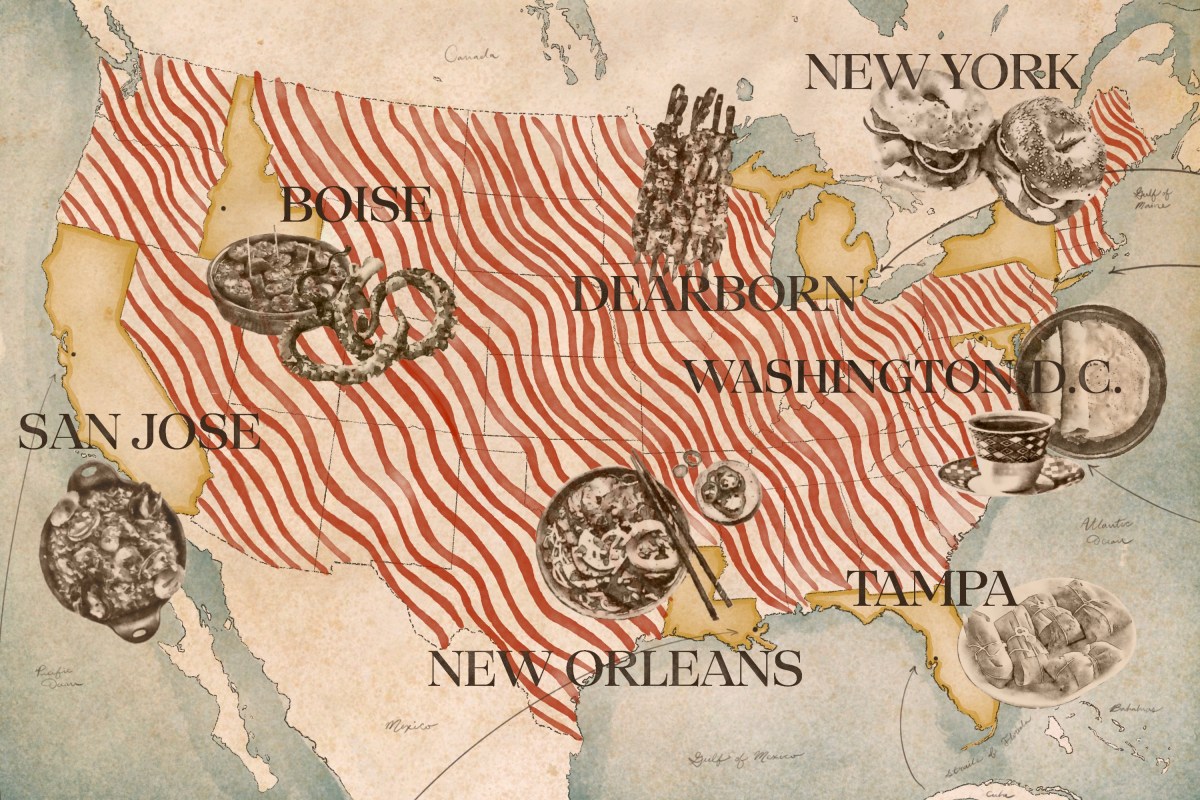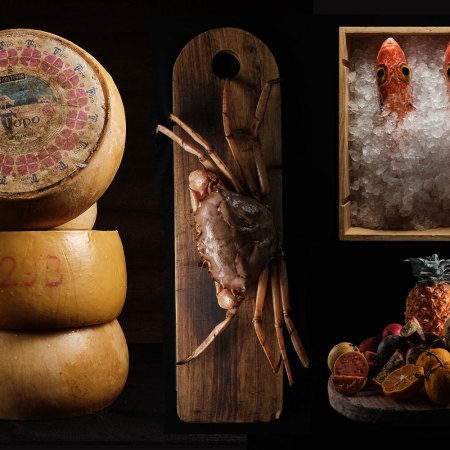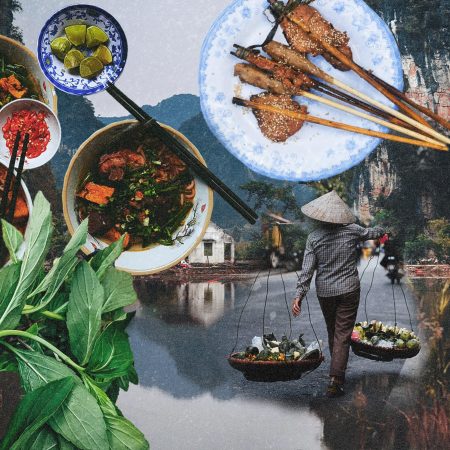
The history of America is a story of immigration, with lapping waves of hopeful newcomers bringing with them not only their dreams and aspirations, but also the flavors, aromas and recipes that defined the essence of their homelands. Common misconception might dictate that the immigrant enclaves which have formed (and continue to evolve) are solely found in big cities, but that’s far from the truth. Rich culinary diasporas have taken root and are thriving in some of the most unlikely places across the country.
For the uninitiated, a culinary diaspora refers to the spread and preservation of a group’s culinary traditions and cuisine in different parts of the world as a result of migration. It emphasizes how food can become a crucial aspect of cultural identity and continuity for communities living away from their original homeland.
“The concept of a diaspora is dispersal, so when people are in a cultural diaspora, they find themselves far away from the customs and traditions they associate with their place of origin,” says Vivian Nun Halloran, author of The Immigrant Kitchen: Food, Ethnicity, and Diaspora.
Across the country in big cities and small towns, bustling cultural enclaves serve as living testaments to the resilience of culinary traditions in the face of assimilation. For these immigrants and their kin, food becomes a source of comfort beyond mere sustenance, a means of storytelling and a manifestation of identity.
“Culinary traditions are easiest to pass down through the generations because people cook and feed one another within the comfort and privacy of their home spaces, away from the judgments of members of the dominant culture,” Halloran says. “Eating foods from home reassures immigrants they are still the people they were, even as they forge a new life. Likewise, by passing down the tastes of home across generations, even family members who do not all speak the same language or share memories of the same birthplace can partake of a shared culture.”

Sacred Spaces Shared
The kitchens of immigrant households are sacred spaces, where recipes are passed down from one generation to the next, ensuring the survival of cultural practices that might otherwise be lost in the currents of change. Whether it’s the comforting spices of Indian dishes, the savory delights of Mexican street food or the nuanced flavors of Vietnamese phở, these culinary traditions become a source of comfort and familiarity for immigrants, helping them maintain a sense of belonging. In many communities, ambitious cooks also become food-focused business owners, sharing beloved family recipes with their wider community and a growing number of curious foodies.
“Hospitality is not just an industry but also a foundational value in many cultures,” Halloran says. “Trying new or unfamiliar foods helps us understand the world a little better. It’s one of the few embodied experiences we can all share at the same level. Liking a new dish (or not) only shows you something about yourself and your preferences rather than anything fundamental about another country. Thinking about what foods we most enjoy and how to explain that to someone else can be a fun way to break down cultural barriers.”
For many immigrant business owners, opening the doors to their own restaurant might also mean dulling down spice, fusing the tenets of their cuisine with that of popular local dishes or “modernizing” the presentation of dishes for the visual palate of prospective diners. Regardless, each restaurant serves as a window into a different place — their original home or the home of their ancestors.
Whether you happen to be Boise, New Orleans, Dearborn or New York City, there is a rich sense of community (and a cuisine) waiting to be discovered and acknowledged.


Vietnamese Cuisine in New Orleans, Louisiana
In a vibrant city revered for its flavorful po’ boys, another sandwich has also woven itself into New Orleans’s gastronomic fabric: the banh mi.
“I grew up in New Orleans East, where many Vietnamese immigrated after the war in 1975,” says Nini Nguyen, a Vietnamese chef and the author of Dặc Biệt. “My family, along with other Vietnamese immigrants, found a new home because of the support of the Catholic church because the church wanted to keep the Vietnamese community tightly-knit. Maintaining cultural ties was a significant aspect of our community, especially in the realm of food. When Vietnamese people first arrived, adapting to a new country meant preserving the flavors of our homeland.”
Following the fall of Saigon in 1975, a wave of Vietnamese refugees sought sanctuary in the United States, a significant number of them finding a new home in New Orleans. Drawn by its welcoming atmosphere, burgeoning seafood industry and shared French colonial history, Vietnamese immigrants quickly became an integral part of the local community. With them, they brought a rich culinary heritage, introducing dishes such as phở (a flavorful noodle soup with an aromatic broth), banh mi (a Vietnamese sandwich) and spring rolls to the city’s culinary landscape.
“Almost 50 years later, the landscape has evolved,” Nguyen says. “What was once a struggle to find familiar ingredients has transformed into a flourishing community with farms and farmers markets. When I was a kid, I remembered people would sell vegetables grown from seeds brought from Vietnam.”
The dynamic food culture of New Orleans has also given rise to creative and delicious fusion interpretations of Vietnamese dishes. Chefs in the city have embraced the art of blending culinary traditions, resulting in innovative dishes that reflect both Vietnamese and New Orleans flavors. A prime example is Dong Phuong Bakery, a revered Vietnamese restaurant in the Big Easy. Known for its banh mi sandwiches, flavorful phở and an array of traditional pastries, it captures the essence of Vietnamese comfort food. Nguyen also makes mention of their king cakes, a NOLA staple during Mardi Gras, which showcases the establishment’s evolution during the past 40 years to incorporate more local dishes and flavors.
“One of the standout dishes at Dong Phuong is their Bún Bò Huế, a personal favorite of mine,” Nguyen says. “Beyond that, their array of traditional pastries in the bakery section is nothing short of phenomenal. The fusion of restaurant and bakery seamlessly weaves together classic flavors, making it a go-to spot for those seeking an authentic culinary experience. It’s an establishment that has not only stood the test of time but has also become a staple in the culinary landscape of New Orleans.”


Cuban Cuisine in Tampa, Florida
The history of Cuban immigration to Tampa technically dates all the way back to the 1520s, but it wasn’t until the late 19th and early 20th centuries that the port city witnessed a wave of Cuban arrivals, drawn by opportunities in the thriving cigar industry. Ybor City, the historic district of Tampa, became a focal point and remains a hub of Cuban culture. With them, these immigrants brought a vibrant culinary heritage, introducing flavors and techniques that would come to define Tampa’s gastronomic identity.
The iconic Cubano, or Cuban sandwich, emerged as a fusion of Cuban and local ingredients, featuring ham, roast pork, Swiss cheese, pickles, mustard and sometimes salami, pressed between Cuban bread. Another popular dish is ropa vieja, or shredded beef simmered in a flavorful tomato-based sauce with peppers and onions. Picadillo is a ground beef dish seasoned with a mix of sweet and savory flavors, often featuring raisins and olives, and arroz con pollo is also a classic.
For a taste of authentic Cuban cuisine in Tampa, a trip to family-owned Columbia Restaurant is a must. Founded in 1905 in Ybor City, it’s Florida’s oldest restaurant, serving up traditional Cuban dishes in a historic setting. La Teresita is another beloved spot known for its homestyle Cuban cooking. The family-owned restaurant has been a Tampa institution for decades, offering classics like ropa vieja and picadillo.
For a more contemporary take on Cuban cuisine, Hemingway’s Cuban Kitchen blends traditional flavors with American twists, such as a Cuban-style steak sandwich stuffed with crispy shoestrings and caramelized onions. In Ybor City, the family-owned and operated La Segunda Central Bakery is a must-visit for authentic Cuban sandwiches, pastries and bread.


Ethiopian Cuisine in Washington, D.C.
Our nation’s capital is well known as a political epicenter, but many are unaware of just how diverse the territory is — it’s home to several thriving immigrant communities and was once the only African American majority city in the country. One of the most impactful culinary diasporas in D.C. is that of the Ethiopian community, thanks to immigrants journeying to seek higher education opportunities at Howard (a Historically Black College or University, or HBCU) in the mid-20th century.
Then, in 1974, the onset of what became a brutal 16-year communist regime in the East African country also prompted an influx of those seeking peace and refuge to begin new lives in the District of Columbia. The city’s Adams Morgan neighborhood emerged as the epicenter of the Ethiopian community, where numerous Ethiopian restaurants and businesses opened as safe spaces of culture and gathering. D.C. is now home to one of the largest Ethiopian communities in the United States, with an estimated population exceeding 35,000.
Iconic Ethiopian dishes such as injera — a spongy flatbread made from teff flour that serves as a vessel for various sauces and stews — can be found all around the city, not just in specific cultural enclaves like Adams Morgan. In fact, many Ethiopian restaurant owners have migrated their businesses either northward or southward to the more affordable pastures of Maryland and Northern Virginia, where communities continue to thrive. Still operating in Adams Morgan, albeit not in its original location, is Elfegne, a restaurant that uniquely represents the evolution of Ethiopian cuisine and community in D.C.
“Since opening in 1993 as Zenebech [the restaurant’s original name], we initially began as a bakery,” says owner Mahlet Woldemariam. “Over time, we’ve observed significant changes in the Ethiopian community and the food scene in D.C. There’s been a surge in interest in Ethiopian cuisine, leading to its wider acceptance and enjoyment in the food scene. The community has expanded, and Ethiopian dishes are now gaining popularity in mainstream dining.”
Family-owned and operated Elfegne has remained a steward for traditional Ethiopian cuisine for three decades, serving up comforting classics such as awaze tibs, a rich, meaty stew eaten with injera; kitfo, minced meat served with a spiced clarified butter; and doro wat, a spicy stew of boneless chicken served with a boiled egg. In early 2023, the restaurant renamed itself Elfegne after royal dining halls and received a nod from the Michelin guide.
Besides the kaleidoscope of other incredible D.C. Ethiopian restaurants that are worth a visit — Dukem, Das and Chercher, just to name a few — the city’s H Street corridor is also home to cafe Sidamo that serves as a unique harbor for Ethiopian culture. There, beans are roasted in-house daily, and Ethiopian coffee ceremonies are performed on Sundays.


Basque Cuisine in Boise, Idaho
While Boise might not seem like an obvious choice for Basque settlers at first, the history of their immigration to the area is intertwined with a long background of sheepherding and the opportunities they sought in that burgeoning industry here in the United States. Basque Country, where the ethnic group immigrated from, spans a mountainous region of Northeast Spain and Southwestern France. Their own distinct language, called Euskara, is the only surviving pre-Indo-European language in Western Europe.
Drawn to the Boise area with the promise of work in the late 19th and early 20th centuries, they brought with them a rich culinary tradition that has since left a lasting imprint on the local food scene. Basque cuisine, characterized by its hearty and flavorful dishes, quickly became a beloved part of Boise’s gastronomic landscape. From the iconic Basque chorizo to the communal dining experience of family-style meals, Basque culinary contributions have become an integral part of Boise’s diverse and delicious food culture — especially on the Basque Block.
A vibrant cultural district that serves as a focal point for the city’s Basque community, the Basque Block is a hub of cultural heritage and traditions — from the Basque Center (a community gathering place) to the Basque Market and Basque Museum, the only museum in North America dedicated to the culture, art and history of the Basque people. Boise even has their own Basque preschool that teaches Euskara, and events like the San Inazio Festival draw visitors from near and far to experience Basque music, dance and traditional dishes like chorizo a la sidra, a flavorful sausage dish cooked in cider.
Perhaps the most well-known type of Basque cuisine, and one you can find aplenty in Boise restaurants and pubs like Bar Gernika and Epi’s (in nearby Meridian), is pintxos. Similar to Spanish tapas, these bite-sized delights are often enjoyed in social settings like bars and taverns and range from simple combinations — like a slice of cured ham on bread — to more elaborate and sophisticated creations, such as grilled octopus with aioli or smoked salmon with cream cheese.


Arab and Middle Eastern Cuisine in Dearborn, Michigan
Not exactly the best-known city on the planet, some might be surprised to hear that Dearborn, Michigan, two postcodes to the west of Detroit, actually boasts one of the largest Arab American populations in the country — certainly in terms of percentage, at an impressive 47%. Dating back to the early 20th century, Arab immigrants, primarily of Lebanese, Yemeni and Syrian descent, sought economic opportunities in Dearborn’s burgeoning industrial landscape.
The Arab American National Museum, located in Dearborn, stands as a testament to this rich cultural heritage, offering insights into the community’s history, art and contributions to American life. Culinary enthusiasts can explore the intersection of culture and cuisine through the museum’s tours, which provide a unique opportunity to savor and appreciate the flavors that have become an essential part of Dearborn’s multicultural tapestry.
Iconic establishments serve classic dishes like shawarma, where marinated and roasted meat is thinly sliced and often tucked into warm pita bread with flavorful condiments. Kibbeh, a dish consisting of ground meat and bulgur formed into patties, is widely enjoyed and can be found at places like Hamido. Another beloved dish is grape leaves (warak enab) that are stuffed with a mixture of rice, meat and spices, creating a savory and aromatic delicacy available at establishments like O’Smeen Grill in the Detroit metro area.
Mansaf, a traditional Jordanian dish, can be savored at restaurants like Al Sultan Grill. It features lamb cooked in a yogurt-based sauce and is often served over rice. Additionally, restaurants like Hamido in Dearborn showcase the flavors of traditional desserts with options like baklava and knafeh, sweet treats made with layers of phyllo dough, nuts and honey. The Detroit metro area’s Arab American culinary landscape is marked by these diverse and flavorful dishes, each carrying the essence of a rich cultural heritage and contributing to the mosaic of flavors that make the region’s food scene so distinctive.


Portuguese Cuisine in San Jose, California
Drawn by economic prospects of the agricultural industry, a wave of Portuguese immigrants settled in the fertile Santa Clara Valley in the mid-19th century. Many came from the Azores islands where they contributed to the region’s agricultural and dairy industries back home. These immigrants brought with them a culinary heritage deeply rooted in maritime traditions and Mediterranean influences, and San Jose — known for its status as one of the most ethnically-diverse cities in the United States — has embraced the Portuguese community’s rich culinary contributions.
San Jose’s Little Portugal, a vibrant neighborhood on the northeastern side of the city, was once home to one of the largest populations of Portuguese in the country. Though the neighborhood is now a mixing pot with a large Hispanic population, there are still Portuguese culinary gems to be found.
Petiscos, by husband-and-wife duo Carlos and Fernanda Carreira, is perhaps the best example of Portuguese fare in the city today. The two are also the team behind Adega, which stood as the only Michelin-starred Portuguese restaurant in the country until they decided to shutter the concept recently to focus on expanding Petiscos. There, you’ll find everything from approachable croquettes to Portuguese classics like pig’s ear salad and linguiça with braised peas, all in the style of simple yet delicious homestyle cooking.
You also can’t go wrong with taking a more casual walking and eating tour of the neighborhood, grabbing up delicious items like bifana, a Portuguese sandwich filled with marinated and seasoned pork from The Bacalhau Grill, and iconic custard tarts pastéis de nata from Popular Portuguese Bakery of San Jose.


Jewish Cuisine in New York, New York
The history of Jewish immigration to New York is deeply intertwined with the city’s culinary landscape. In the late 19th and early 20th centuries, waves of Jewish immigrants, primarily from Eastern Europe, sought refuge in Brooklyn and the Lower East Side of Manhattan, establishing vibrant communities. These newcomers opened delicatessens, bagel shops and kosher markets, which all became integral to NYC’s gastronomic identity. Over the years, iconic Jewish dishes like pastrami sandwiches and knishes have become synonymous with these culinary offerings, and today there are nearly one million Jewish residents, making up a significant portion of the city’s cultural and culinary fabric.
Neighborhoods like Williamsburg, Crown Heights, the Lower East Side and Borough Park have historically been home to significant Jewish communities. South Williamsburg, for example, is known for its artisanal food culture, with Jewish bakeries offering traditional challah and rugelach alongside innovative twists on classic recipes. Iconic establishments like Russ & Daughters, Katz’s Delicatessen and Zabar’s have been feeding Manhattan for decades.
Newer businesses like Mile End Delicatessen, which serves Montreal-style Jewish deli fare, have also entered the mix in recent years. Shelsky’s of Brooklyn beckons aficionados with sublime smoked fish, freshly baked bagels and an array of delectable deli items. Its namesake founder, Peter Shelsky, describes himself as “Jew(ish)” and explains that the culinary scene in Brooklyn has seen an evolution of Jewish offerings, thanks to spots such as The Gefilteria, Mile End, Edith’s, Gertie and Frankel’s.
“We’ve put our own spin on how we relate to the food we grew up eating,” Shelsky says. “The cuisine has been updated and modernized but not completely changed. We pay closer attention to detail, we source better ingredients, we do things a little bit differently than in decades past. We’re not really reinventing the wheel, though. We sell nostalgia — we just do it in a somewhat unique way. But it’s important we don’t lose sight of the fact that we’re selling that feeling of ‘It smells like Bubby’s house in here!’”
Join America's Fastest Growing Spirits Newsletter THE SPILL. Unlock all the reviews, recipes and revelry — and get 15% off award-winning La Tierra de Acre Mezcal.



